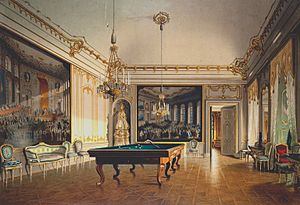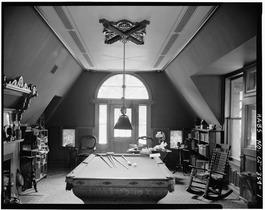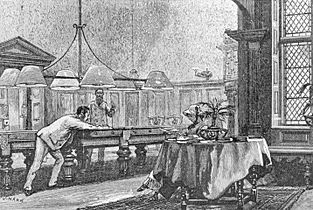Billiard room facts for kids

A billiard room is a special room, often found in homes or community centers, that has a billiards, pool, or snooker table. It's a fun place where people can play cue sports. Sometimes, a "billiard room" or "pool room" can also mean a business where you pay to play on public tables, like a billiard hall.
This room can be in a public part of a house, like a living area, or in a more private space. For playing games well, billiard rooms need good lighting. They also need enough space around the table. It's best to have about 5 feet (1.5 meters) of clear space around the table for players to move their cue sticks easily.
A famous interior designer named Charlotte Moss once said that a billiard room is great for groups. She believed it's a place where friends can gather, enjoy drinks, and have some friendly games.
Contents
History of Billiard Rooms
How Billiards Began
Billiards likely started from outdoor games played in the late 1300s or early 1400s. In these games, players used sticks to hit balls on the grass. The first time we hear about pool as an indoor table game was in 1470. This was in a list of items owned by King Louis XI of France.
Billiard Rooms Become Popular
After the French Revolution and the Napoleonic Wars, billiard rooms became popular. They were added to famous cafes in Paris and other cities during the 1700s.
Billiard Rooms in Great Britain
For a long time, both men and women enjoyed playing billiards. However, in 19th-century Great Britain, a new trend started. Many large homes began to have special areas just for men. These "male suites" often included a billiard room, a smoking room, and sometimes a library.
Castle Carr Example
One example of these special male areas is Castle Carr, located near Halifax. By the early 1900s, billiard rooms were seen as a standard feature in grand British houses. A magazine called House Beautiful even stated that "Up-to-date owners of English estates have installed billiard rooms..."
Design and Style
Many billiard rooms in the mid-to-late 1800s were designed in an Oriental style or a Moorish style. These styles used patterns and decorations inspired by Eastern cultures. For example, the billiard room of famous writer Mark Twain in Hartford, Connecticut, had decorations with a Moorish feel. The late 1800s and early 1900s were the most popular time for billiard rooms.
-
The Billiard Room at the Mark Twain House.
-
A sketch of The Club in Bedford Park, London, from 1880.



